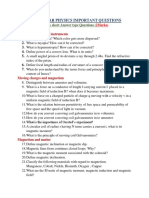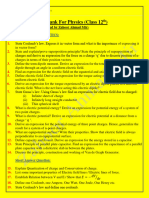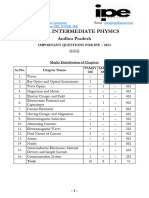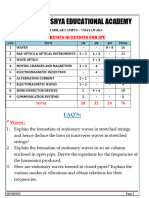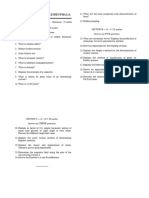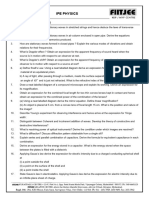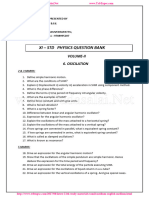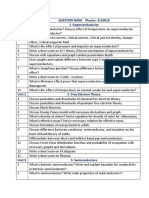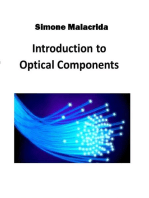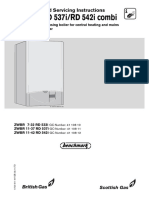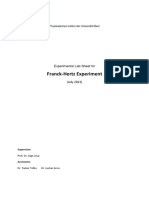0 ratings0% found this document useful (0 votes)
15 viewsChapter - 14 Time: 35 Mins Physics II-Test Total Marks: 20
Chapter - 14 Time: 35 Mins Physics II-Test Total Marks: 20
Uploaded by
ranaateeqThis document contains 24 short answer questions related to physics concepts including:
1) Uses of cathode ray oscilloscope (CRO), Lorentz force formulation, magnetic flux and density, solenoids, stable galvanometers, tesla units, magnetic fields outside solenoids, galvanometers, CRO parts, controlling CRO screen brightness, CRO anode functions, sweep generators, time base generators, galvanometer principles and sensitivity, increasing galvanometer sensitivity, ohmmeters, behavior of charged particles in magnetic fields, using current loops to detect magnetic fields, using magnetic fields to separate isotopes, properties of ammeters, effects of changing solenoid length/turns on magnetic field.
Copyright:
© All Rights Reserved
Available Formats
Download as DOCX, PDF, TXT or read online from Scribd
Chapter - 14 Time: 35 Mins Physics II-Test Total Marks: 20
Chapter - 14 Time: 35 Mins Physics II-Test Total Marks: 20
Uploaded by
ranaateeq0 ratings0% found this document useful (0 votes)
15 views1 pageThis document contains 24 short answer questions related to physics concepts including:
1) Uses of cathode ray oscilloscope (CRO), Lorentz force formulation, magnetic flux and density, solenoids, stable galvanometers, tesla units, magnetic fields outside solenoids, galvanometers, CRO parts, controlling CRO screen brightness, CRO anode functions, sweep generators, time base generators, galvanometer principles and sensitivity, increasing galvanometer sensitivity, ohmmeters, behavior of charged particles in magnetic fields, using current loops to detect magnetic fields, using magnetic fields to separate isotopes, properties of ammeters, effects of changing solenoid length/turns on magnetic field.
Original Title
short question 14.docx
Copyright
© © All Rights Reserved
Available Formats
DOCX, PDF, TXT or read online from Scribd
Share this document
Did you find this document useful?
Is this content inappropriate?
This document contains 24 short answer questions related to physics concepts including:
1) Uses of cathode ray oscilloscope (CRO), Lorentz force formulation, magnetic flux and density, solenoids, stable galvanometers, tesla units, magnetic fields outside solenoids, galvanometers, CRO parts, controlling CRO screen brightness, CRO anode functions, sweep generators, time base generators, galvanometer principles and sensitivity, increasing galvanometer sensitivity, ohmmeters, behavior of charged particles in magnetic fields, using current loops to detect magnetic fields, using magnetic fields to separate isotopes, properties of ammeters, effects of changing solenoid length/turns on magnetic field.
Copyright:
© All Rights Reserved
Available Formats
Download as DOCX, PDF, TXT or read online from Scribd
Download as docx, pdf, or txt
0 ratings0% found this document useful (0 votes)
15 views1 pageChapter - 14 Time: 35 Mins Physics II-Test Total Marks: 20
Chapter - 14 Time: 35 Mins Physics II-Test Total Marks: 20
Uploaded by
ranaateeqThis document contains 24 short answer questions related to physics concepts including:
1) Uses of cathode ray oscilloscope (CRO), Lorentz force formulation, magnetic flux and density, solenoids, stable galvanometers, tesla units, magnetic fields outside solenoids, galvanometers, CRO parts, controlling CRO screen brightness, CRO anode functions, sweep generators, time base generators, galvanometer principles and sensitivity, increasing galvanometer sensitivity, ohmmeters, behavior of charged particles in magnetic fields, using current loops to detect magnetic fields, using magnetic fields to separate isotopes, properties of ammeters, effects of changing solenoid length/turns on magnetic field.
Copyright:
© All Rights Reserved
Available Formats
Download as DOCX, PDF, TXT or read online from Scribd
Download as docx, pdf, or txt
You are on page 1of 1
Chapter -14
Time: 35 mins Physics II-Test-B22 Total Marks: 20
Q. No. 1 Write 16-short answers to the following questions. 1.25×16=20
1. What are the uses of CRO?
2. What is Lorentz force and how can it be formulated?
3. Define magnetic flux and flux density.
4. What is a solenoid?
5. What is a stable galvanometer?
6. Define tesla. Write its mathematical formula.
7. Why is 𝐵 ⃗ non-zero outside a solenoid?
8. Define galvanometer and cathode ray oscilloscope.
9. Write main parts of CRO.
10. How brightness on the screen of CRO can be controlled?
11. What are the functions of Anodes in CRO?
12. What is the function of sweep generator in cathode ray oscilloscope?
13. What is time base generator?
14. Define galvanometer. Write down its principle.
15. Define current sensitivity of galvanometer.
16. How can galvanometer be made sensitive?
17. How can we increase the sensitivity of galvanometer?
18. Write a short note on “Ohm-meter”.
19. Two charged particles are projected into a region where there is a magnetic field perpendicular to
their velocities. If the charges are deflected in opposite directions, what can you say about them?
20. How can a current loop be used to determine the presence of a magnetic field in a given region of
space?
21. How can you use a magnetic field to separate isotopes of chemical element?
22. Why the resistance of an ammeter should be very low?
23. Describe the change in the magnetic field inside a solenoid carrying a steady current I, if (a) the
length of the solenoid is doubled but the number of turns remains the same and (b) the number of
turns is doubled, but the length remains the same.
24. A plane conducting loop is located in a uniform magnetic field that is directed along the x-axis.
For what orientation of the loop is the flux a maximum? For what orientation is the flux a
minimum?
STANDARD ACADEMY PHALIA PHONE/WHATSAPP @ 0333-4947086
You might also like
- Physics 2 Yr Important QuestionDocument5 pagesPhysics 2 Yr Important QuestionyashwantNo ratings yet
- SR Phy Papers PDFDocument5 pagesSR Phy Papers PDFMahesh KanthNo ratings yet
- PHYSICS-IInd YEAR (Board List)Document2 pagesPHYSICS-IInd YEAR (Board List)cherukunavaNo ratings yet
- 12th Physics All Units Important and Creative Short Answer Questions English Medium PDF DownloadDocument8 pages12th Physics All Units Important and Creative Short Answer Questions English Medium PDF Downloadkaviradha555No ratings yet
- SR IPE Physics Previous Papers (AP)Document14 pagesSR IPE Physics Previous Papers (AP)Anonymous nepp2H0No ratings yet
- PhysicsDocument3 pagesPhysicsranaateeqNo ratings yet
- Ts Senior Inter Sub: Physics Important Questions I Very Short Questions: Question No:1Document5 pagesTs Senior Inter Sub: Physics Important Questions I Very Short Questions: Question No:1Yuga Tejeshwar Reddy100% (3)
- SR PhysicsDocument5 pagesSR Physicssambaguntupalli4No ratings yet
- Physics 2nd Year Imp ShortDocument5 pagesPhysics 2nd Year Imp ShortTabish SaeedNo ratings yet
- PhysicsDocument4 pagesPhysicsaliakbarbhatti2006No ratings yet
- 12th Class Guess Papers 2024 Phy ShortDocument6 pages12th Class Guess Papers 2024 Phy ShortpremiocrownNo ratings yet
- Physics SR Important QuestionsDocument5 pagesPhysics SR Important Questionssaisupreeth0913No ratings yet
- SR Physics Most ImportantDocument5 pagesSR Physics Most ImportantShahrukh KhanNo ratings yet
- Ec6016 Optoelectronics QB 2013 RegDocument7 pagesEc6016 Optoelectronics QB 2013 Regsridharparthipan0% (1)
- Physics Section Wise Important Questions WMDocument7 pagesPhysics Section Wise Important Questions WMShashank BNo ratings yet
- MIDTERM-1 - SR - MPC& SB - PHY - Q.PDocument2 pagesMIDTERM-1 - SR - MPC& SB - PHY - Q.Paashrith624050.napaNo ratings yet
- Physics NotesDocument8 pagesPhysics Noteshassan51121314No ratings yet
- Phy SeniorsDocument6 pagesPhy SeniorsRaj KumarNo ratings yet
- 12thQuestionBank (KSU)Document9 pages12thQuestionBank (KSU)sohailmushtaq1001No ratings yet
- Physics Second Year Model PapersDocument5 pagesPhysics Second Year Model PapersShahrukh KhanNo ratings yet
- Chemistry V SEM P 6Document17 pagesChemistry V SEM P 6sanjay sNo ratings yet
- Senior Physics Ipe Imp Question Bank 2019-20Document10 pagesSenior Physics Ipe Imp Question Bank 2019-20Soumendu KonaeNo ratings yet
- SR Physics Fast LearnerDocument7 pagesSR Physics Fast LearnerShahrukh KhanNo ratings yet
- TS - SR - Physics - Imp - Questions 2023-24-1Document5 pagesTS - SR - Physics - Imp - Questions 2023-24-1jsjhhahsjnkkjsjNo ratings yet
- 12th PHY ImpDocument6 pages12th PHY ImpmuzaffarusNo ratings yet
- Physics Important QuestionsDocument4 pagesPhysics Important Questionskothapallimalleshwari04No ratings yet
- Class Note of Sourav Roy Sir: Problem:1Document2 pagesClass Note of Sourav Roy Sir: Problem:1Md.Atikur RahmanNo ratings yet
- DealDocument7 pagesDealNasim ShahNo ratings yet
- 1 Physics 2014 To 2018 JulyDocument6 pages1 Physics 2014 To 2018 JulyRavi Kumar100% (1)
- SASTRA First Year Physics Question BankDocument10 pagesSASTRA First Year Physics Question Bankstar100% (1)
- TS - SR - Physics - Imp - Questions 2022-23Document5 pagesTS - SR - Physics - Imp - Questions 2022-23Kota ๖ۣۜRαkͥesͣhͫ0% (1)
- 12th Class Physics Guess PaperDocument4 pages12th Class Physics Guess PaperzeeshanNo ratings yet
- TS - SR - Physics - Imp - Questions 2023-24Document5 pagesTS - SR - Physics - Imp - Questions 2023-24shlokjaju6No ratings yet
- Sr. Physics IPE Imp. QuestionsDocument15 pagesSr. Physics IPE Imp. Questionsscs672885krishnaNo ratings yet
- SR Mains & Neet - Mid Term-2 - Phy Q'SDocument7 pagesSR Mains & Neet - Mid Term-2 - Phy Q'ST Nageswara RaoNo ratings yet
- SR Physics - Ipe - Important Questions: Very Short Answer QuestionsDocument8 pagesSR Physics - Ipe - Important Questions: Very Short Answer QuestionsRithik Reddy100% (1)
- KSEEB II PU PHYSICS Model Question Paper 2020 21 Set 2Document2 pagesKSEEB II PU PHYSICS Model Question Paper 2020 21 Set 2kumbarprajwal24No ratings yet
- PH3151 QB 01Document5 pagesPH3151 QB 01mayankraj1744No ratings yet
- CBSE Sample Paper 7: General InstructionDocument5 pagesCBSE Sample Paper 7: General InstructionMohit KumarNo ratings yet
- N21UPHA11ADocument2 pagesN21UPHA11Atnesaiah03No ratings yet
- Physics II (EM) Model PaperDocument3 pagesPhysics II (EM) Model PaperSiva sankarNo ratings yet
- Very Imp QNS - 12TH PhyDocument11 pagesVery Imp QNS - 12TH Physheshankanbazhagan06No ratings yet
- SECOND For UkDocument8 pagesSECOND For UkyellaiahNo ratings yet
- Physics ImportantquestDocument6 pagesPhysics ImportantquestGummi Sravya Reddy100% (1)
- Applied Physics Question bankDocument6 pagesApplied Physics Question banksivakumariandrajuNo ratings yet
- Ece II Engineering Physics (10phy 22) AssignmentDocument7 pagesEce II Engineering Physics (10phy 22) AssignmentPrakash ShiggaviNo ratings yet
- Final SR Physics Smart-QnsDocument3 pagesFinal SR Physics Smart-QnskeerthNo ratings yet
- Physics Assignment 2024-25Document22 pagesPhysics Assignment 2024-25mandaarapucollege123No ratings yet
- PHYSICS IMPORTANT QUESTIONSDocument3 pagesPHYSICS IMPORTANT QUESTIONSvishruthamurali2007No ratings yet
- CBSE Sample Paper Class 12 Physics Set 3: All Questions Are Compulsory. There Are 27 Questions in AllDocument4 pagesCBSE Sample Paper Class 12 Physics Set 3: All Questions Are Compulsory. There Are 27 Questions in AllI dont have a NameNo ratings yet
- Wave DynamicsDocument5 pagesWave DynamicspothirajNo ratings yet
- SAMPLE PAPER-09 (Unsolved)Document3 pagesSAMPLE PAPER-09 (Unsolved)ShantanuSinghNo ratings yet
- 11th Physics Question BankDocument5 pages11th Physics Question Bankroronoazoro.tokyoNo ratings yet
- Sr. PhysicsDocument6 pagesSr. PhysicsMavuluri UmamaheshNo ratings yet
- Ec2151-Electric Circuits and Electron Devices: Question BankDocument8 pagesEc2151-Electric Circuits and Electron Devices: Question BankabvajaNo ratings yet
- Ts SR Physics Imp Questions 2023-24Document5 pagesTs SR Physics Imp Questions 2023-24s.pranay11.reddy100% (1)
- Question Bank 3110018Document3 pagesQuestion Bank 3110018saler71625No ratings yet
- 2nd PUC Question Papers Physics 2006-2010Document21 pages2nd PUC Question Papers Physics 2006-2010Mohan Kumar P100% (1)
- PH3151 - Part-A Possible QuestionsDocument3 pagesPH3151 - Part-A Possible QuestionsGowtham KumarasamyNo ratings yet
- WOR785Document124 pagesWOR785ranaateeqNo ratings yet
- CS402 Mid Term PapersDocument38 pagesCS402 Mid Term PapersranaateeqNo ratings yet
- Linear Algebra McqsDocument10 pagesLinear Algebra McqsranaateeqNo ratings yet
- Superior Group of Colleges Mandi BahauddinDocument3 pagesSuperior Group of Colleges Mandi BahauddinranaateeqNo ratings yet
- PSHCD 83 AdvDocument3 pagesPSHCD 83 AdvranaateeqNo ratings yet
- PSHCD Dha AdDocument3 pagesPSHCD Dha AdranaateeqNo ratings yet
- Mcqs 5 UnitDocument6 pagesMcqs 5 UnitranaateeqNo ratings yet
- MCQ of Electronics Devices by Thomas FloydDocument14 pagesMCQ of Electronics Devices by Thomas FloydranaateeqNo ratings yet
- Assignment 3Document4 pagesAssignment 3ranaateeqNo ratings yet
- Chapter 13 ElectronicsDocument18 pagesChapter 13 ElectronicsranaateeqNo ratings yet
- Physics of Solids - 17 Time: 35 Mins Physics II-Test-Total Marks: 20Document1 pagePhysics of Solids - 17 Time: 35 Mins Physics II-Test-Total Marks: 20ranaateeqNo ratings yet
- Superior Group of Colleges: Mandi Bahauddin CampusDocument1 pageSuperior Group of Colleges: Mandi Bahauddin CampusranaateeqNo ratings yet
- Lec 1Document26 pagesLec 1ranaateeqNo ratings yet
- (A) (B) 4 (C) 1 (D) 2Document2 pages(A) (B) 4 (C) 1 (D) 2ranaateeqNo ratings yet
- Franck-Hertz Experiment: Experimental Lab Sheet ForDocument10 pagesFranck-Hertz Experiment: Experimental Lab Sheet ForranaateeqNo ratings yet
